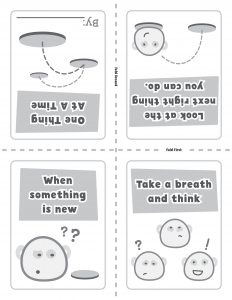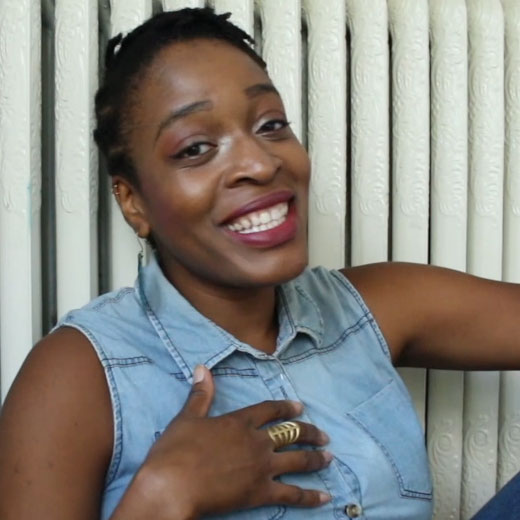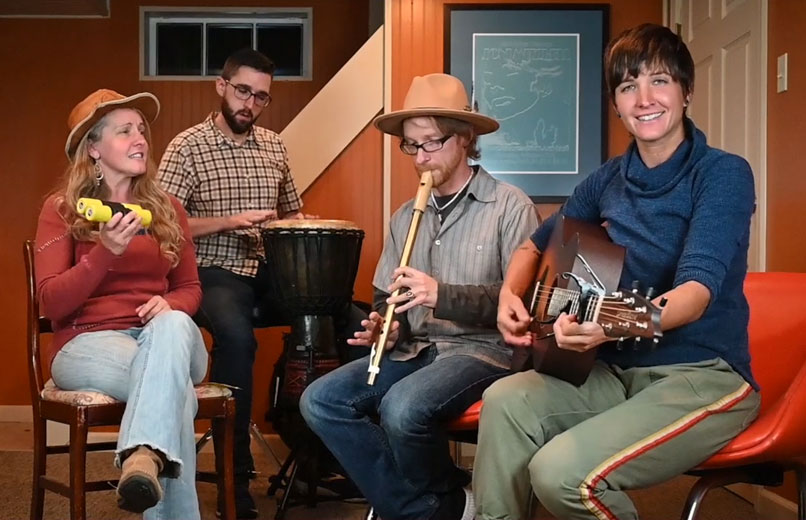Change can be exciting for young children, but it doesn’t always feel good. Being out of their routine can make children feel confused and unhappy. When we can help prepare children for changes that are coming- like helping them think about questions they have or practicing a new situation—they often feel more prepared and calm about change. However, sometimes change happens quickly and is unavoidable. It is helpful to encourage children to focus on the next right thing and not everything at once. That’s good advice for us as adults too.
One Thing at a Time
When things feel different because they’re new
You feel jumbled up inside it’s true
You focus on the next right thing
And all the good that it will bring
Chorus:
Change brings something new
It may not feel right to you
Take a breath – you will be fine
Think of one thing at a time
Yeah – One Thing At A Time!
A lot has changed for me and you
But there are things that still are true
We can say this from the heart
You are safe and you are smart
Chorus:
Change brings something new
It may not feel right to you
Take a breath – you will be fine
Think of one thing at a time
Yeah – One Thing At A Time!
©2020 Tepsich/Welsh
Activities
Think About It
Standard:16.1.PK-K.A – Distinguish between emotions and identify socially accepted ways to express them. 16.2.PK-K.5S Express an opinion about a story or experience using visual supports and speaking prompts (e.g., I think…; I like…).
Explore these questions with your child:
- What are some things that have changed?
- How did those changes make you feel?
- Who are some people you can talk to about change?
Do It
Caterpillars
Standard:10.4.PK.A – Demonstrate coordination of body movements in active play 10.4.K.B.2 Engage in large motor activities that require strength and balance.
Demonstrate how caterpillars change into butterflies by acting out the life cycle of a butterfly:
Act Out the Life Cycle of a Butterfly
Blow Bubbles
Standard: 10.5.PK.B – Coordinate eye and hand movements to perform a task 16.1.PK.A – Distinguish between emotions and identify socially accepted ways to express them
Everyone loves bubbles! Grab some bubble wands and head outside. Teach your students how to properly breathe deeply with the bubbles. Breathe in deeply and exhale slowly while blowing the bubbles out. Blowing bubbles can help us relax and calm our bodies down.
Imagine Calm
Standard: 16.1.PK.A – Distinguish between emotions and identify socially accepted ways to express them
When a child is calm, ask them to close their eyes and think about how their body is feeling. Does they feel light or heavy? Encourage them to share details about how they feel. Then, when your child is feeling anxious, remind them to close their eyes and visualize their calming place.
Make It
Measure
Standard: 2.4.PK-K.A.1 – Describe and compare measurable attributes of length and weights of everyday objects 4.4.PK.A – Identify what plants and animals need to grow 3.3.4.B – Know that living things are made up of parts that have specific functions.
Because children love to see how tall they’ve grown, try marking your child’s height on a wall or growth chart. Repeat this every few months and note how much taller they are.
Seasonally, try measuring plants in a garden. Do they get taller?
Caterpillars/Butterflies
Standard: 3.1.PK.A.5 – Name the basic parts of living things 3.3.4.B – Know that living things are made up of parts that have specific functions. 3.1.4.C – Illustrate patterns that regularly occur and reoccur in nature. 3.2.4.A – Identify and use the nature of scientific and technological knowledge.
Make a butterfly costume. Talk about how butterflies changed from caterpillars.
Our Tree
Standard:3.1.PK.A.5 – Name the basic parts of living things 4.1.PK.E – Identify the change of seasons in the environment 3.3.4.B – Know that living things are made up of parts that have specific functions. 3.1.4.C – Illustrate patterns that regularly occur and reoccur in nature. 1.4.PK-K.B Use a combination of drawing, dictating, and writing.
Draw four trees on four separate pieces of paper to represent the four seasons.
For example:
- Spring: draw flowers in the tree and a sun and clouds in the sky
- Summer: draw lots of leaves in the tree and a big sun in the sky
- Fall: draw some leaves in the tree and some falling off the tree and on the ground
- Winter: draw a tree with no leaves and snow.
Talk with your child about their favorite season.
Matter Can Change
Standard:3.2.PK.A.1 – Sort and describe objects according to size, shape, color, and texture. 3.4.4.A – Recognize basic concepts about the structure and properties of matter.
Have your child put water into an ice cube tray or small container and then put it in the freezer. See how long it takes for the water to freeze and become a solid ice cube. Then, have your child put one ice cube in a glass and see how long it takes to melt. Will it melt faster if the temperature is hotter? As the ice cubes begin to melt, talk about the changes you observe.
Stress Balls
Standard:10.5.PK.A – Use hands, fingers, and wrists to manipulate objects 16.1.PK.A – Distinguish between emotions and identify socially accepted ways to express them
Make your own stress balls. Take an un-inflated balloon and fill with play dough or rice. You can add a drop or 2 of essential oils to the play dough for a calming scent. Your kids can pick balloon colors or play dough colors that represent calmness or bravery to them. Tie the balloon closed. Then, children can keep the stress balls at home or in their desks to squeeze when they are experiencing tension. Supervise young children as small items in the balloon could become a choking hazard.
Share It
Talk About It
Standard: 16.1.PK-K.A – Distinguish between emotions and identify socially accepted ways to express them. 16.2.PK-K.5S Express an opinion about a story or experience using visual supports and speaking prompts (e.g., I think…; I like…).
Discuss changes with children using language they can understand. Allow children to express the feelings they may have. Reassure children that all different feelings are acceptable.
Offer Information
Standard: 16.1.PK-K.A – Distinguish between emotions and identify socially accepted ways to express them. 16.1. PK.B – Recognize that everyone has personal traits which guide behavior and choices
Ask your child, “What are you worried about?” or “What are you afraid might happen?” to clarify their concerns. Sometimes kids are frightened because they have misunderstood a situation or don’t have key pieces of information. As the Daniel Tiger song reminds us, when we are scared, we should “see what it is, you might feel better.”
Read About It
Little Tree, by Loren Long
Little Tree learns about the challenges of growing up and letting go by watching what happens when you are unwilling to change.
The Leaving Morning, by Angela Johnson
A child thinks about moving and all the change it brings.
Wherever You Go, by Pat Zietlow Miller
Roads take us where we want to go but sometimes there are detours along the way. We can choose which way we go.











